Ernest Lawrence
Ernest Lawrence | |
|---|---|
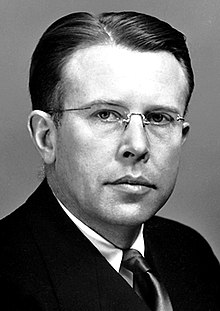 Lawrence in 1939 | |
| Born | Ernest Orlando Lawrence August 8, 1901 Canton, South Dakota, U.S. |
| Died | August 27, 1958 (aged 57) Palo Alto, California, U.S. |
| Education | |
| Known for | |
| Spouse |
Mary K. Blumer (m. 1932) |
| Children | 6 |
| Relatives | John H. Lawrence (brother) |
| Awards | See list
|
| Scientific career | |
| Fields | Physics |
| Institutions | |
| Thesis | The Photoelectric Effect in Potassium Vapor as a Function of the Frequency of the Light (1924) |
| Doctoral advisor | William Francis Gray Swann |
| Doctoral students | See list
|
| Signature | |
Ernest Orlando Lawrence (August 8, 1901 – August 27, 1958) was an American nuclear physicist and winner of the Nobel Prize in Physics in 1939 for his invention of the cyclotron. He is known for his work on uranium-isotope separation for the Manhattan Project, as well as for founding the Lawrence Berkeley National Laboratory and the Lawrence Livermore National Laboratory.
A graduate of the
Lawrence went on to build a series of ever larger and more expensive cyclotrons. His Radiation Laboratory became an official department of the University of California in 1936, with Lawrence as its director. In addition to the use of the cyclotron for physics, Lawrence also supported its use in research into medical uses of radioisotopes. During
After the war, Lawrence campaigned extensively for government sponsorship of large scientific programs, and was a forceful advocate of "
Early life
Ernest Orlando Lawrence was born in Canton, South Dakota, on August 8, 1901. His parents, Carl Gustavus (1871–1954) and Gunda Regina (née Jacobson) Lawrence (1874–1959), were both the offspring of Norwegian immigrants who had met while teaching at the high school in Canton, where his father was also the superintendent of schools. He had a younger brother, John H. Lawrence, who would become a physician, and was a pioneer in the field of nuclear medicine. Growing up, his best friend was Merle Tuve, who would also go on to become a highly accomplished physicist.[1]
Lawrence attended the public schools of Canton and Pierre, then enrolled at St. Olaf College in Northfield, Minnesota, but transferred after a year to the University of South Dakota in Vermillion.[2] He completed his bachelor's degree in chemistry in 1922,[3] and his Master of Arts (M.A.) degree in physics from the University of Minnesota in 1923 under the supervision of William Francis Gray Swann. For his master's thesis, Lawrence built an experimental apparatus that rotated an ellipsoid through a magnetic field.[4][5][6]
Lawrence followed Swann to the
With Jesse Beams from the University of Virginia, Lawrence continued to research the photoelectric effect. They showed that photoelectrons appeared within 2 x 10−9 seconds of the photons striking the photoelectric surface—close to the limit of measurement at the time. Reducing the emission time by switching the light source on and off rapidly made the spectrum of energy emitted broader, in conformance with Werner Heisenberg's uncertainty principle.[11]
Early career
In 1926 and 1927, Lawrence received offers of
Lawrence was hired as an
While at Yale, Lawrence met Mary Kimberly (Molly) Blumer, the eldest of four daughters of George Blumer, the dean of the
Development of the cyclotron
Invention
The invention that brought Lawrence to international fame started out as a sketch on a scrap of a paper napkin. While sitting in the library one evening in 1929, Lawrence glanced over a journal article by Rolf Widerøe,[27] and was intrigued by one of the diagrams.[28] This depicted a device that produced high-energy particles by means of a succession of small "pushes". The device depicted was laid out in a straight line using increasingly longer electrodes.[29] At the time, physicists were beginning to explore the atomic nucleus. In 1919, the New Zealand physicist Ernest Rutherford had fired alpha particles into nitrogen and had succeeded in knocking protons out of some of the nuclei. But nuclei have a positive charge that repels other positively charged nuclei, and they are bound together tightly by a force that physicists were only just beginning to understand. To break them up, to disintegrate them, would require much higher energies, of the order of millions of volts.[30]
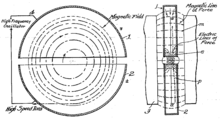
Lawrence saw that such a particle accelerator would soon become too long and unwieldy for his university laboratory. In pondering a way to make the accelerator more compact, Lawrence decided to set a circular accelerating chamber between the poles of an electromagnet. The magnetic field would hold the charged protons in a spiral path as they were accelerated between just two semicircular electrodes connected to an alternating potential. After a hundred turns or so, the protons would impact the target as a beam of high-energy particles. Lawrence excitedly told his colleagues that he had discovered a method for obtaining particles of very high energy without the use of any high voltage.[31] He initially worked with Niels Edlefsen. Their first cyclotron was made out of brass, wire, and sealing wax and was only four inches (10 cm) in diameter—it could be held in one hand, and probably cost a total of $25 (equivalent to $600 in 2023).[22][32]
What Lawrence needed to develop the idea was capable graduate students to do the work. Edlefsen left to take up an assistant professorship in September 1930, and Lawrence replaced him with David H. Sloan and
Development
In what would become a recurring pattern, as soon as there was the first sign of success, Lawrence started planning a new, bigger machine. Lawrence and Livingston drew up a design for a 27-inch (69 cm) cyclotron in early 1932. The magnet for the $800 11-inch cyclotron weighed 2 tons, but Lawrence found a massive 80-ton magnet rusting in a junkyard in Palo Alto for the 27-inch that had originally been built during World War I to power a transatlantic radio link.[35][36] In the cyclotron, he had a powerful scientific instrument, but this did not translate into scientific discovery. In April 1932, John Cockcroft and Ernest Walton at the Cavendish Laboratory in England announced that they had bombarded lithium with protons and succeeded in transmuting it into helium. The energy required turned out to be quite low—well within the capability of the 11-inch cyclotron. On learning about it, Lawrence sent a wire to Berkeley and asked for Cockcroft and Walton's results to be verified. It took the team until September to do so, mainly due to lack of adequate detection apparatus.[37]
Although important discoveries continued to elude Lawrence's Radiation Laboratory, mainly due to its focus on the development of the cyclotron rather than its scientific use, through his increasingly larger machines, Lawrence was able to provide crucial equipment needed for experiments in high energy physics. Around this device, he built what became the world's foremost laboratory for the new field of nuclear physics research in the 1930s. He received a patent for the cyclotron in 1934,[38] which he assigned to the Research Corporation,[39] a private foundation that funded much of Lawrence's early work.[40]
In February 1936, Harvard University's president, James B. Conant, made attractive offers to Lawrence and Oppenheimer.[41] The University of California's president, Robert Gordon Sproul, responded by improving conditions. The Radiation Laboratory became an official department of the University of California on July 1, 1936, with Lawrence formally appointed its director, with a full-time assistant director, and the university agreed to make $20,000 a year available for its research activities (equivalent to $350,000 in 2023).[42] Lawrence employed a simple business model: "He staffed his laboratory with graduate students and junior faculty of the physics department, with fresh Ph.D.s willing to work for anything, and with fellowship holders and wealthy guests able to serve for nothing."[43]
Reception
Using the new 27-inch cyclotron, the team at Berkeley discovered that every element that they bombarded with recently discovered
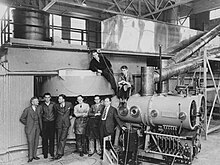
When he returned to Berkeley, Lawrence mobilized his team to go painstakingly over the results to gather enough evidence to convince Chadwick. Meanwhile, at the Cavendish laboratory, Rutherford and Mark Oliphant found that deuterium fuses to form helium-3, which causes the effect that the cyclotroneers had observed. Not only was Chadwick correct in that they had been observing contamination, but they had overlooked yet another important discovery, that of nuclear fusion.[48] Lawrence's response was to press on with the creation of still larger cyclotrons. The 27-inch cyclotron was superseded by a 37-inch cyclotron in June 1937,[49] which in turn was superseded by a 60-inch cyclotron in May 1939. It was used to bombard iron and produced its first radioactive isotopes in June.[50]
As it was easier to raise money for medical purposes, particularly cancer treatment, than for nuclear physics, Lawrence encouraged the use of the cyclotron for medical research. Working with his brother John and Israel Lyon Chaikoff from the University of California's physiology department, Lawrence supported research into the use of radioactive isotopes for therapeutic purposes.

Lawrence was awarded the
In March 1940,
World War II and the Manhattan Project
Radiation Laboratory
After the outbreak of
Lawrence offered Segrè a job as a research assistant—a relatively lowly position for someone who had discovered an element—for US$300 a month for six months. However, when Lawrence learned that Segrè was legally trapped in California, he reduced Segrè's salary further to US$116 a month.[60] When the regents of the University of California wanted to terminate Segrè's employment owing to his foreign nationality, Lawrence managed to retain Segrè by hiring him as a part-time lecturer paid by the Rockefeller Foundation. Similar arrangements were made to retain his doctoral students Chien-Shiung Wu (a Chinese national) and Kenneth Ross MacKenzie (a Canadian national) when they graduated.[61]
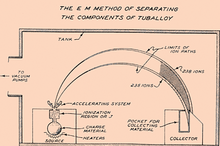
In September 1941, Oliphant met with Lawrence and Oppenheimer at Berkeley, where they showed him the site for the new 184-inch (4.7 m) cyclotron. Oliphant, in turn, took the Americans to task for not following up the recommendations of the British
Lawrence began converting his old 37-inch cyclotron into a giant mass spectrometer.
Electromagnetic isotope separation used devices known as calutrons, a hybrid of two laboratory instruments, the mass spectrometer and cyclotron. The name was derived from "California university cyclotrons".[66] In November 1943, Lawrence's team at Berkeley was bolstered by 29 British scientists, including Oliphant.[67][68]
In the electromagnetic process, a magnetic field deflected charged particles according to mass.[69] The process was neither scientifically elegant nor industrially efficient.[70] Compared with a gaseous diffusion plant or a nuclear reactor, an electromagnetic separation plant would consume more scarce materials, require more manpower to operate, and cost more to build. Nonetheless, the process was approved because it was based on proven technology and therefore represented less risk. Moreover, it could be built in stages, and would rapidly reach industrial capacity.[66]
Oak Ridge
Responsibility for the design and construction of the electromagnetic separation plant at Oak Ridge, Tennessee, which came to be called Y-12, was assigned to Stone & Webster. The calutrons, using 14,700 tons of silver, were manufactured by Allis-Chalmers in Milwaukee and shipped to Oak Ridge. The design called for five first-stage processing units, known as Alpha racetracks, and two units for final processing, known as Beta racetracks. In September 1943 Groves authorized construction of four more racetracks, known as Alpha II.[71] When the plant was started up for testing on schedule in October 1943, the 14-ton vacuum tanks crept out of alignment because of the power of the magnets and had to be fastened more securely. A more serious problem arose when the magnetic coils started shorting out. In December Groves ordered a magnet to be broken open, and handfuls of rust were found inside. Groves then ordered the racetracks to be torn down and the magnets sent back to the factory to be cleaned. A pickling plant was established on-site to clean the pipes and fittings.[70]
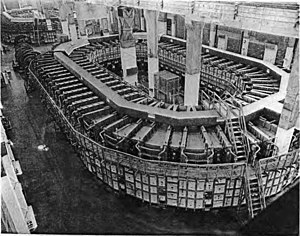
On July 16, 1945, Lawrence observed the
Lawrence hoped that the Manhattan Project would develop improved calutrons and construct Alpha III racetracks, but they were judged to be uneconomical.[76] The Alpha tracks were closed down in September 1945. Although performing better than ever,[77] they could not compete with K-25 and the new K-27, which commenced operation in January 1946. In December, the Y-12 plant was closed, thereby cutting the Tennessee Eastman payroll from 8,600 to 1,500 and saving $2 million a month.[78] Staff numbers at the Radiation laboratory fell from 1,086 in May 1945 to 424 by the end of the year.[79]
Post-war career
Big Science
After the war, Lawrence campaigned extensively for government sponsorship of large scientific programs. He was a forceful advocate of Big Science with its requirements for big machines and big money, and in 1946 he asked the Manhattan Project for over $2 million for research at the Radiation Laboratory (equivalent to $24,000,000 in 2023). Groves approved the money, but cut a number of programs, including Seaborg's proposal for a "hot" radiation laboratory in densely populated Berkeley, and John Lawrence's for production of medical isotopes, because this need could now be better met from nuclear reactors. One obstacle was the University of California, which was eager to divest its wartime military obligations. Lawrence and Groves managed to persuade Sproul to accept a contract extension.[80] In 1946, the Manhattan Project spent $7 on physics at the University of California for every dollar spent by the university.[81]
To most of his colleagues, Lawrence appeared to have almost an aversion to mathematical thought. He had a most unusual intuitive approach to involved physical problems, and when explaining new ideas to him, one quickly learned not to befog the issue by writing down the differential equation that might appear to clarify the situation. Lawrence would say something to the effect that he didn't want to be bothered by the mathematical details, but "explain the physics of the problem to me." One could live close to him for years, and think of him as being almost mathematically illiterate, but then be brought up sharply to see how completely he retained his skill in the mathematics of classical electricity and magnetism.
Luis Alvarez[82]
The 184-inch cyclotron was completed with wartime dollars from the Manhattan Project. It incorporated new ideas by Ed McMillan, and was completed as a
Responsibility for the
Notwithstanding the fact that he voted for
Thermonuclear weapons
Lawrence was alarmed by the
Lawrence strongly backed Edward Teller's campaign for a second nuclear weapons laboratory, which Lawrence proposed to locate with the MTA Mark I at Livermore, California. Lawrence and Teller had to argue their case not only with the Atomic Energy Commission, which did not want it, and the Los Alamos National Laboratory, which was implacably opposed but with proponents who felt that Chicago was the more obvious site for it.[98] The new laboratory at Livermore was finally approved on July 17, 1952, but the Mark II MTA was canceled. By this time, the Atomic Energy Commission had spent $45 million on the Mark I, which had commenced operation, but was mainly used to produce polonium for the nuclear weapons program. Meanwhile, the Brookhaven National Laboratory's Cosmotron had generated a 1 GeV beam.[99]
Death and legacy
In addition to the Nobel Prize, Lawrence received the
In July 1958, President
Almost immediately after Lawrence's death, the Regents of the University of California voted to rename two of the university's nuclear research labs after Lawrence: the Lawrence Livermore National Laboratory and the Lawrence Berkeley National Laboratory.[111] The Ernest Orlando Lawrence Award was established in his memory in 1959.[112] Chemical element number 103, discovered at the Lawrence Berkeley National Laboratory in 1961, was named lawrencium after him.[113] In 1968 the Lawrence Hall of Science public science education center was established in his honor.[114] His papers are in the Bancroft Library at the University of California in Berkeley.[115]
In the 1980s, Lawrence's widow petitioned the University of California Board of Regents on several occasions to remove her husband's name from the Lawrence Livermore Laboratory, due to its focus on nuclear weapons Lawrence helped build, but was denied each time.[116][117][118][119] She outlived her husband by more than 44 years and died in Walnut Creek, California, at the age of 92 on January 6, 2003.[18][19]
Before him, "little science" was carried out largely by lone individuals working with modest means on a small scale. After him, massive industrial, and especially governmental, expenditures of manpower and monetary funding made "big science," carried out by large-scale research teams, a major segment of the national economy.[120]
Lawrence is portrayed by Josh Hartnett in Christopher Nolan's 2023 film Oppenheimer.[121]
References
Citations
- ^ Childs 1968, pp. 23–30, 476–477.
- ^ Childs 1968, pp. 47–49.
- ^ Childs 1968, p. 61.
- ^ Childs 1968, pp. 63–68.
- ^ a b "Inventor of cyclotron dies after surgery". Eugene Register-Guard. (Oregon). Associated Press. August 28, 1958. p. 5B. Retrieved May 24, 2015.
- ^ Berdahl, Robert M. (December 10, 2001). "The Lawrence Legacy". Vermillion, South Dakota: University of California, Berkeley. Office of the Chancellor. Retrieved May 9, 2014.
- ^ a b Alvarez 1970, pp. 253–254.
- ^ Alvarez 1970, p. 288.
- .
- ^ Childs 1968, p. 93.
- ^ Alvarez 1970, p. 256.
- ^ Childs 1968, pp. 107–108.
- ^ Childs 1968, pp. 120–121.
- ^ Bonolis, Luisa (May 27, 2014). "Prof. Dr. Irène Joliot-Curie Research Profile". Lindau Nobel Laureate Meetings. Retrieved August 12, 2023.
- ^ Alvarez 1970, pp. 271.
- ^ Childs 1968, p. 256.
- ^ Brechin 1999, p. 312.
- ^ a b c Yarris, Lynn (January 8, 2003). "Lab mourns death of Molly Lawrence, widow of Ernest O. Lawrence". Lawrence Berkeley National Laboratory. Archived from the original on March 3, 2016. Retrieved May 9, 2014.
- ^ a b "Obituaries: Mary Lawrence". The Berkleyan. University of California. January 15, 2003. Retrieved May 9, 2014.
- ^ a b Alvarez 1970, p. 259.
- ^ Childs 1968, p. 182.
- ^ a b Allen, John F. (August 29, 1958). "Cyclotron father's death mourned". Milwaukee Sentinel. p. 13, part 1.[permanent dead link]
- ^ Childs 1968, p. 309.
- ^ Herken 2002, pp. 11–15.
- ^ a b Kiessling, E.C. (December 17, 1968). "Even geniuses have human frailties". Milwaukee Journal. p. 24, part 1.[permanent dead link]
- ^ "The Nobel Prize in Chemistry 1951". Nobel Foundation. 2014. Retrieved June 21, 2015.
- S2CID 109942448.
- ^ "Breaking Through: A Century of Physics at Berkeley. 2. The Cyclotron". Bancroft Library, UC Berkeley. February 25, 2012. Archived from the original on May 27, 2012.
- ^ Heilbron & Seidel 1989, pp. 75–82.
- ^ Heilbron & Seidel 1989, pp. 46–49.
- ^ Heilbron & Seidel 1989, pp. 83–88.
- ^ "Remembering E. O. Lawrence". Science & Technology Review. October 2001. Archived from the original on June 15, 2013. Retrieved August 25, 2013.
{{cite magazine}}: Unknown parameter|agency=ignored (help) - ^ Heilbron & Seidel 1989, pp. 89–95.
- ^ Heilbron & Seidel 1989, pp. 95–100.
- ^ Herken 2002, pp. 5–7.
- ^ "The Rad Lab – Ernest Lawrence and the Cyclotron". American Institute of Physics. Archived from the original on September 20, 2015. Retrieved September 22, 2013.
- ^ Heilbron & Seidel 1989, pp. 137–141.
- ^ US patent 1948384, Ernest O. Lawrence, "Method and apparatus for the acceleration of ions", issued 1934-02-20
- ^ Heilbron & Seidel 1989, pp. 192–193.
- ^ Heilbron & Seidel 1989, pp. 27–28.
- ^ Childs 1968, pp. 235–237.
- ^ Childs 1968, pp. 240–241, 248.
- ^ Heilbron, J. L.; Seidel, Robert W.; Wheaton, Bruce R. (1981). "Lawrence and His Laboratory – A historian's view of the Lawrence years – Chapter 1: A New Lab for a New Science". Lawrence Berkeley National Laboratory. Retrieved October 5, 2013.
- ^ Heilbron & Seidel 1989, pp. 153–157.
- ^ Heilbron & Seidel 1989, p. 156.
- ^ Childs 1968, pp. 197–208.
- ^ Herken 2002, pp. 9–10.
- ^ Heilbron & Seidel 1989, pp. 169–171.
- ^ Heilbron & Seidel 1989, p. 277.
- ^ a b Childs 1968, p. 288.
- ^ Heilbron & Seidel 1989, pp. 399–404.
- ^ Heilbron & Seidel 1989, pp. 405–414.
- ^ "The Nobel Prize in Physics 1939". The Nobel Foundation. Retrieved August 25, 2013.
- ^ Childs 1968, pp. 294–296.
- ^ Herken 2002, p. 27.
- ^ Childs 1968, p. 299.
- ^ Alvarez 1970, p. 274.
- ^ Childs 1968, pp. 306–308.
- OSTI 5808140. LBL-13492, DE82 004551.
- ^ Segrè 1993, pp. 147–148.
- ^ Heilbron & Seidel 1989, pp. 521–522.
- ^ Herken 2002, pp. 38–41.
- .
- ^ Hewlett & Anderson 1962, pp. 43–44.
- ^ Childs 1968, pp. 337–339.
- ^ a b Jones 1985, pp. 117–119.
- ^ Childs 1968, p. 347.
- ^ Jones 1985, p. 124.
- ^ Childs 1968, p. 312.
- ^ a b Fine & Remington 1972, p. 684.
- ^ Jones 1985, pp. 126–132.
- ^ Jones 1985, p. 140.
- ^ a b Jones 1985, pp. 143–148.
- ^ Childs 1968, pp. 358–359.
- ^ Childs 1968, pp. 360–365.
- ^ Herken 2002, p. 128.
- ^ Hewlett & Anderson 1962, p. 624.
- ^ Hewlett & Anderson 1962, pp. 630, 646.
- ^ Childs 1968, p. 370.
- ^ Herken 2002, p. 168.
- ^ Seidel 1983, p. 398.
- ^ Alvarez 1970, p. 253.
- ^ "Ernest Lawrence's Cyclotron".
- ^ Childs 1968, p. 387.
- ^ Alvarez 1970, pp. 277–279.
- ^ Herken 2002, p. 170.
- ^ Herken 2002, pp. 176, 182–183.
- ^ Childs 1968, p. 186.
- ^ Childs 1968, pp. 319–320.
- ^ a b c Emilie, Haertsch (2016). "Large and in charge". Distillations. 2 (3): 40–43. Retrieved March 22, 2018.
- ^ Herken 2002, pp. 190–192.
- ^ Herken 2002, pp. 220–222.
- ^ Herken 2002, pp. 200–202.
- ^ a b Heilbron, J. L.; Seidel, Robert W.; Wheaton, Bruce R. (1981). "Chapter 5: Cold War in Science". Lawrence and His Laboratory – A historian's view of the Lawrence year. Lawrence Berkeley National Laboratory. Archived from the original on October 6, 2013. Retrieved October 5, 2013.
- ^ Herken 2002, p. 220.
- ^ Herken 2002, pp. 234–235.
- ^ Heilbron, J. L.; Seidel, Robert W.; Wheaton, Bruce R. (1981). "Chapter 6: A Neutron Foundry". Lawrence and His Laboratory – A historian's view of the Lawrence year. Lawrence Berkeley National Laboratory. Archived from the original on October 6, 2013. Retrieved October 5, 2013.
- ^ Herken 2002, pp. 244–247.
- ^ Herken 2002, p. 256.
- ^ a b Alvarez 1970, pp. 285–286.
- ^ Childs 1968, pp. 508–510.
- ^ "Ernest Lawrence". www.nasonline.org. Retrieved May 22, 2023.
- ^ "Ernest Orlando Lawrence". American Academy of Arts & Sciences. February 9, 2023. Retrieved May 22, 2023.
- ^ "APS Member History". search.amphilsoc.org. Retrieved May 22, 2023.
- ^ Childs 1968, pp. 517–518.
- ^ Greene 2007, pp. 156–158, 289.
- ^ Herken 2002, pp. 325–325.
- ^ a b Childs 1968, pp. 532–534.
- ^ "Lawrence, inventor of cyclotron; dies". Oxnard Press-Courier. (California). UPI. August 28, 1958. p. 2.
- ^ Alvarez 1970, p. 283.
- ^ "Photo of the Week: Inside the 60-Inch Cyclotron". United States Department of Energy. Retrieved August 24, 2013.
- ^ "Ernest Orlando Lawrence Award". United States Department of Energy. Retrieved August 24, 2013.
- ^ "100 Years of Scholarship". Cal Alumni. Archived from the original on October 2, 2013. Retrieved August 24, 2013.
- ^ Alvarez 1970, p. 284.
- Online Archive of California. Retrieved May 24, 2015.
- ^ "University rejects widow's request". Ocala Star-Banner. Ocala, FL. Associated Press. July 16, 1983. p. 15A. Retrieved May 24, 2015.
- ^ Savage, David G. (September 7, 1985). "Physicist's widow asks that husband's name be removed from weapons lab". Los Angeles Times. Archived from the original on January 18, 2015. Retrieved May 9, 2014.
- ^ Lawrence, Mary B. (October 1986). "So they say". The Scientist. Retrieved May 9, 2014.
{{cite magazine}}: Unknown parameter|agency=ignored (help) - ^ "Name change". Milwaukee Journal. Associated Press. June 8, 1987. p. 2A. Retrieved May 24, 2015.[permanent dead link]
- Kauffman, George B. (February 2000). "Lawrence, Ernest Orlando". American National Biography Online. Retrieved June 22, 2015.
- ^ Zacharek, Stephanie (July 19, 2023). "Oppenheimer Dazzles With Its Epic Story of a Complicated Patriot". Time. Archived from the original on July 20, 2023. Retrieved July 20, 2023.
Bibliography
- Alvarez, Luis (1970). "Ernest Orlando Lawrence 1901–1958" (PDF). Biographical Memoirs of the National Academy of Sciences. Retrieved August 29, 2023.
- OCLC 40331167.
- Childs, Herbert (1968). An American Genius: The Life of Ernest Orlando Lawrence, Father of the Cyclotron. New York, New York: E. P. Dutton. OCLC 273351.
- Fine, Lenore; Remington, Jesse A. (1972). The Corps of Engineers: Construction in the United States (PDF). Washington, D.C.: United States Army Center of Military History. OCLC 834187. Archived from the original(PDF) on February 1, 2017. Retrieved August 25, 2013.
- Greene, Benjamin P. (2007). Eisenhower, Science Advice, and the Nuclear Test-Ban Debate, 1945–1963. Stanford, California: Stanford University Press. OCLC 65204949.
- OCLC 19455957. Retrieved May 24, 2015.
- OCLC 48941348.
- )
- Jones, Vincent (1985). Manhattan: The Army and the Atomic Bomb (PDF). Washington, D.C.: United States Army Center of Military History. OCLC 10913875. Archived from the original(PDF) on October 7, 2014. Retrieved August 25, 2013.
- OCLC 25629433.
- Seidel, Robert W. (1983). "Accelerating Science: The Postwar Transformation of the Lawrence Radiation Laboratory". Historical Studies in the Physical Sciences. 13 (2): 375–400. JSTOR 27757520.
Further reading
- Bird, Kai, and Martin J. Sherwin. American Prometheus: The Triumph and Tragedy of J. Robert Oppenheimer (2005) online
- Bernstein, Barton J. "Four Physicists and the Bomb: The Early Years, 1945-1950" Historical Studies in the Physical and Biological Sciences (1988) 18#2; covers Oppenheimer, Fermi, Lawrence and Compton. online
- Galison, Peter, and Barton Bernstein. "In any light: Scientists and the decision to build the Superbomb, 1952-1954." Historical Studies in the Physical and Biological Sciences 19.2 (1989): 267–347. online
- Hiltzik, Michael. Big Science: Ernest Lawrence and the Invention that Launched the Military-Industrial Complex (Simon and Schuster, 2015) online
External links
- Ernest O. Lawrence Annotated Bibliography for Ernest Lawrence from the Alsos Digital Library for Nuclear Issues
- Lawrence and the Cyclotron: AIP History Center Web Exhibit
- Ernest Orlando Lawrence – The Man, His Lab, His Legacy Archived November 17, 2015, at the Wayback Machine
- Lawrence and His Laboratory: A Historian's View of the Lawrence Years Archived January 18, 2018, at the Wayback Machine
- Lawrence Livermore Lab: Remembering E. O. Lawrence
- Ernest Lawrence on Nobelprize.org
- Nobel-Winners.com: Ernest Lawrence
- Ernest Lawrence at Find a Grave
